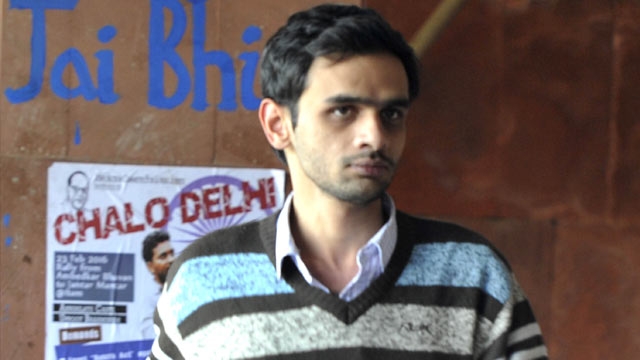Protests And Stones Mar Umar Khalid's Invitation To Ramjas College
NEW DELHI: The English department and English Literary Society of Ramjas College, University of Delhi, had organised a seminar, which include Jawaharlal Nehru University student Umar Khalid on the panel. Khalid had been named in a sedition case a year ago, as protests linked to an event on Afzal Guru at the JNU campus gained widespread media and public attention.
The day started with excitement with a great lineup of speakers who were to discuss the representation of dissent in politics, state, sexuality, literature etc. the program started at 10 am in the morning with a foreboding sense of protest in the air. At around 11 am, a couple of students started collecting in the college, shouting how they are not going to let the “anti-nationalist” Umar Khalid enter in the college.
This collection soon turned into a mob screaming slogans of “Vande Matram” and threatening the organisers, warning them that they will “disfigure their faces” if Umar Khalid dares to speak in the University.
Ironically, these people didn’t even know what Umar Khalid looked liked, nor had any idea what he had done or why was he invited to the college.
A goon, dressed in an orange kurta came into the conference room asking who was the current speaker or the “guy with long hair sitting on the right”. He thought he was Umar and went out of the room threatening, “we won’t let him enter the university” when he realised that Umar hadn’t yet arrived.
Umar Khalid was invited to speak as a part of the panel on Regions in Conflict where he was supposed to present his paper on the Tribals in Bastar. But, the angry ABVP mob stopped that from happening. The police who was called in foresight refused to protect the organisers or Umar Khalid, rendering their own fundamental duty nullified.
The protests resulted in Khalid being disinvited.
After the disinvitation, the organisers and the people present at the seminar decided to peacefully march in the college, protesting this infringement on democracy where discussions and dissent apparently are not tolerated. As the group marched shouting slogans of “Azaadi” from this “gundagardi” (hooliganism), the goons actually started physically assaulting the peaceful protestors in the presence of the police.
They again screamed slogans of “Vande Matram” and “Bharat Mata ki jai” while showing their middle fingers to the women present. Sometimes they just hooted for five minutes as a show of power.
Things got out of hand and the seminar was disrupted. Somehow, the organisers again started the next panel by escorting the interested people to the conference room with the help of the police.
During the first speaker’s address, stones were thrown in the room, shattering the glasses of the area situated on the first floor. The electricity was turned off and everyone in the room was trapped inside in the dark, with a few metres away from the broken windows, ducking behind the chairs, trying to save themselves from this show of power and violence. The only exit was blocked by around a hundred goons, still shouting and now with stones and chappals in their hands. Getting out was hard and dangerous.
What happened in this supposedly democratic space of the university was shameful. A University is supposed to be a place of peaceful dissent and discussion. It is supposed to be a place where ideas flow freely and the status quo is questioned through debates and discussions. It is really sad to see the basic idea of a university being throttled and thrashed by a group along with the utter indifference by the authorities who are supposed to protect us. It shows a deep and dangerous nexus between the state, the political groups sponsored by them and the police. The condition in which this country is now, what happened in Ramjas is not a small, secluded event but it is a small part of the bigger picture where the same fascism and hooliganism is happening all over the country. In this state, a University is supposed to challenge this fascism and authoritarianism. But what to do when an academic institution stops being one and becomes a token of power of the powerful?





